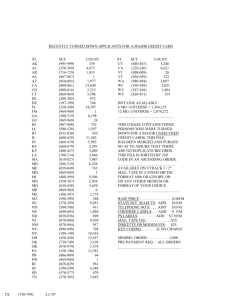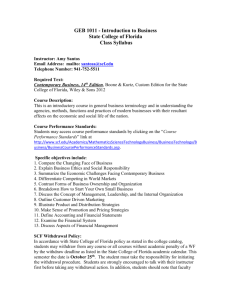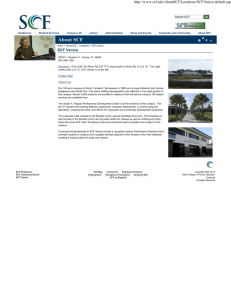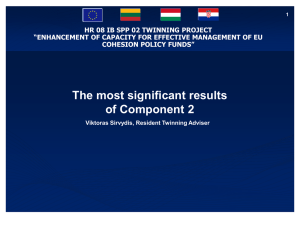Socio-economic development and the global economic crisis
advertisement
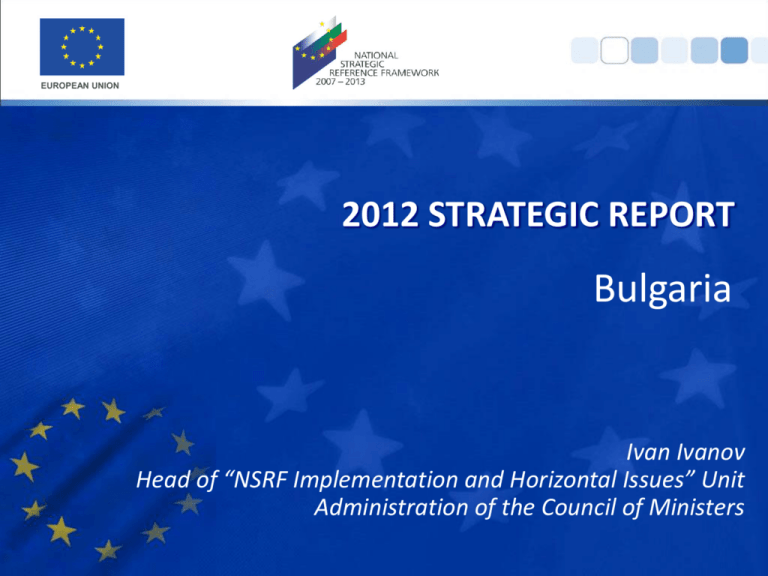
EUROPEAN UNION 2012 STRATEGIC REPORT Bulgaria Ivan Ivanov Head of “NSRF Implementation and Horizontal Issues” Unit Administration of the Council of Ministers Socio-economic development and the global economic crisis (2009-2011) GPD Decline of GDP, limited private investments, slow economic growth (2011: 1.7%) Significant drop in FDI (€ 1.3 billion in 2011) Restricted budget deficit (2.0% of GDP in 2011), but limited public investments Stable banking system Increased unemployment rate (11.2% in 2011) 6.4% 6.5% 6.4% 6.2% 0.4% 2005 2006 2007 2008 2009 2010 1.7% 2011 -5.5% 9051.8 FDI 6727.8 6221.6 3152.1 2436.9 1208.5 1341.2 2005 2006 2007 2008 2009 2010 2011 Socio-economic development: Main challenges Education and labour market participation: improving situation but still low level of participation in lifelong learning Research, innovations and competitiveness: relatively high rate of innovation system growth but still very limited investments in R&D Infrastructure and IT: developed road network but significant renovation is needed; high level of investments in ICT but still lower internet penetration rates than EU-27 Energy efficiency: highest energy intensity of economy in EU, high dependence on imported energy resources, although slightly decreasing Business and institutional environment: e-government is being introduced but major changes (including development and upgrade of IT infrastructure) are still pending Physical Progress: Indicators Significant progress against baseline values for most indicators Negative trends in indicators affected by the crisis: GDP growth, FDI, labour market indicators Most target values estimated feasible by the end of 2015 Core indicators: Modest performance against target values, but 60% of all indicators with significant improvement as compared to the 2009 Strategic report Over-achievement of the target values for 2 indicators No progress has been reported yet under 10 indicators, but achievement will be reported based on completed projects Non-core indicators follow similar performance trends Physical Progress: Achievements 13 km. of metro lines and 13 new metro stations constructed; 380 000 of Sofia citizens with access to improved public transport 82 km. of new roads and 16,3 km. of new railroads constructed 454 km. of roads and 126 km. of railroads reconstructed additional population served by waste water projects - 194 970 p.e. one regional waste management system constructed 63 investments made for improvement of the cultural infrastructure and 60 other for improvement of the social services’ infrastructure 622 367 people using the improved small-scale infrastructure 565 346 people benefitted from the renovated buildings 1 647 jobs created; investments amounting to € 225 million induced 130 SMEs introducing new technologies/products supported 911 enterprises supported through loan instruments Physical Progress: Achievements (2) 59 692 unemployed persons involved in professional trainings; 51 619 persons employed after training 88 223 persons involved in measures for prevention of early school leaving 820 forms of social services launched and 256 existing ones supported 146 judiciary bodies have introduced a system for case management 100 administrations with systems for internal flow of documents 2 100 administrative services being provided online 25 499 employees of civil society structures trained 174 trainings for local authorities and other structures working under SCF conducted; 3 323 experts trained 299 experts trained to work with UMIS 28 information centres established and being functional Financial Progress /million €/ 2009 2012 Strategic report Strategic as of as of Report 31.12.2011 30.10.2012 /30.09.2009/ contracted funds 1 609,96 5 250,89 7 588,02 contracted funds (%) 20,08% 65,48% 94,62% payments 161,68 1 505,63 2 458,74 payments/ contracted funds (%) 10,04% 28,67% 32,40% certification 94,39 1 121,90 1 998,98 58,38% 74,51% 81,30% certification/ payments (%) 94,62% of the total OP budget contracted by the end of October 2012 30,7% of the funds – paid to beneficiaries Growth in payments rate is lower than the growth in contracting Tranches received by EC (advance and interim) amount to 1 900 mln. € 78,8% of all contracted funds have been awarded since September 2009 More than 1/3 of all grant contracts signed in JanuaryOctober 2012 Allocations to operations selected and Lisbon strategy Contracted funds /million €/ 8,000.00 7,000.00 non-earmarked 6,000.00 Lisbon earmarked 5,000.00 4,000.00 44,70% 3,000.00 46,15% 2,000.00 1,000.00 55,30% 55,39% 53,85% 44,61% 0.00 Budget allocations 2009 SR (30.09.2009) 2012 SR (31.12.2011) Financial Progress by OPs /million €/ 2,500.00 OP Budget 2,000.00 Contracted Paid 1,500.00 Certified 1,000.00 500.00 0.00 OPT OPE OPRD OPHRD OPC OPAC OPTA Supported areas and EUROPE 2020 National objectives set in NRP: Better infrastructure - OPT, OPE and OPRD Competitive youth - OPHRD Better business environment - OPC and OPAC Greater trust in state institutions - OPC and OPAC Complemented by activities focused on: Improving the efficiency of public expenses in support of growth - OPHRD and OPRD Providing institutional and financial support for the enterprises - OPC Reducing unemployment among the most vulnerable groups of society (youth, lowqualified and discouraged persons and elderly) - OPHRD Net impact of SCF on economic development Growing positive role of SCF for the economic development due to: Higher absorption level Very limited public and private investments caused by the economic crisis Focus of the funds on the growth engines: technological development and human capital and infrastructure Crucial effect on the positive levels of GDP Almost full absorption of SCF is expected to lead to 9.3% higher levels of real GDP by 2015 The impact does not end with the end of the programming period: a positive impact on real GDP is currently estimated up to 11.6% by the end of 2020 Net impact of SCF on real GDP 9.3% Employment (15-64), 1000s 3600 3500 7.1% 3400 3300 4.9% 3200 3.0% Baseline scenario - no SCF absorption 3100 Alternative scenario - maximum SCF absorption 3000 1.6% 2900 0.5% 2800 2010 2011 2012 2013 2014 2015 2009 2010 2011 2012 2013 2014 2015 Net impact of SCF on economic development (2) The net impact of Structural instruments for 2009–2012 on other core macro-economic indicators is as follows: Private consumption is 3.9% higher in real terms compared to the scenario with zero absorption Government consumption is 8.8% higher in real terms Private investments are 5.4% higher in real terms Government investments are 26.3% higher in real terms The number of employees is 4.0% higher (on average for the period 2011-2012 employment generated in the economy as a result of funding under the OPs amounts to 105 000) The unemployment rate is 2.4 p.p. lower The average salary in the country is 5.9% higher in nominal terms Inflation is not affected by the funds spentunder SCF The budget balance is improved by 0.8 p.p. The share of public debt in GDP is 1.7 p.p. lower With a view to next programming period… CHALLENGES scattering of investments lack of former experience with SCF lack of resources for prefinancing and co-financing project activities heavy procedures and excessive administrative burden for beneficiaries overlapping of controls – both between the MAs and IBs, and between control bodies LESSONS LEARNT importance of high-quality strategic planning and programming based on an active dialogue with partners focus on "growth engines" leading to regional convergence importance of measures for strengthening the administrative capacity e-procedures as the most effective tool for reduction of administrative burden balance between sound financial management and efficiency Conclusions SCF - crucial factor for the economic recovery of the country and the real convergence to EU-27 Contribution of SCF in 2012 GDP growth is 80% 2009-2012 net impact on the number of employed people is 4.0% (approximately 105 000 jobs) and 2.4% lower unemployment Positive impact on incomes - in 2012 it is 5.9% higher in nominal terms due to SCF, and by 2015 this effect is expected to reach 33.6% The results of SCF interventions are now visible Further efforts towards achieving the targets set are still needed, however significant progress has been made since 2009 THANK YOU FOR YOUR ATTENTION!
